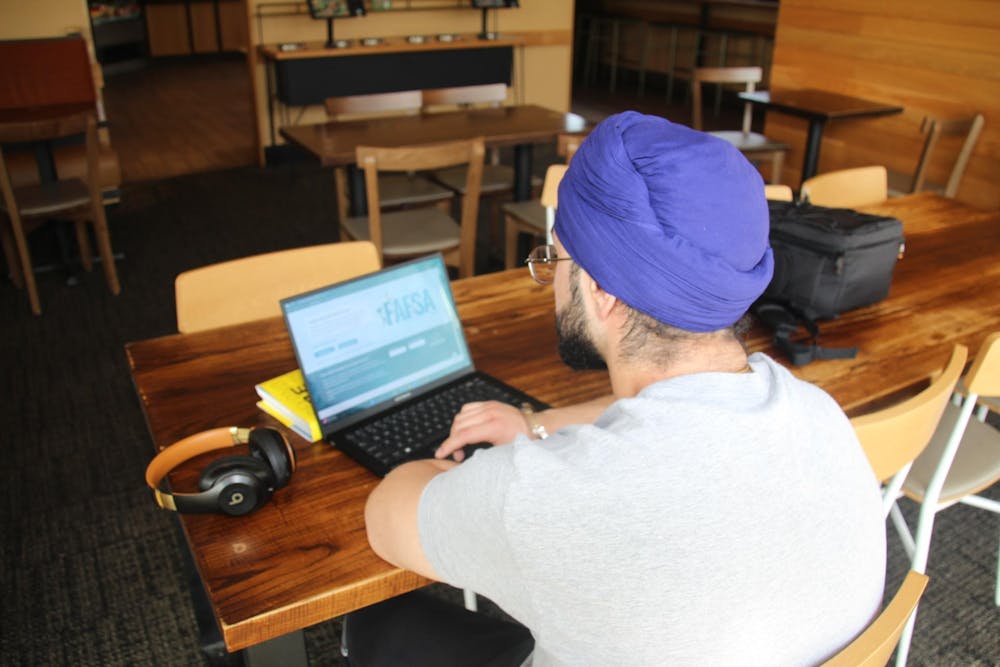Fewer Monroe County high school students have completed the Free Application for Federal Student Aid, or FAFSA, in 2024 than in 2023. The priority deadline is April 15. With a newly updated FAFSA and a new state law requiring nearly all Indiana students to complete the FAFSA, here’s what you need to know.
11.9% fewer Monroe County high school students have filled out the FAFSA in 2024 than in 2023 as of March 29. Out of 366 estimated seniors at Bloomington High School North, only 157 filled out the FAFSA this year. At Bloomington High School South, the completion rate is 194 out of an estimated 361, and at Edgewood High School in Ellettsville, it’s only 67 out of an estimated 196.
This isn’t the first year students have struggled to fill out the FAFSA. In 2022, only 58.8% of students in Monroe County Community School Corporation submitted the form.
This year, however, a new law means all Indiana students, with some exceptions, are required to fill out the FAFSA. Exceptions include if parents or emancipated students sign a waiver declining to complete the form or if parents are unreachable after two attempts. Sen. Jean Leising, who authored the bill, said she hopes this will increase Indiana’s college-going rate.
Ultimately, though, students should fill out the FAFSA for the money that’s available, Allison Kuehr, associate commissioner for marketing and communications for the Indiana Commission for Higher Education, said. Last year, she said, the Indiana high school class of 2023 left over $76 million in Pell Grants on the table because they didn’t fill out the FAFSA.
To access that money, though, students need to fill out the form. A new version of the FAFSA form was rolled out Dec. 31, 2023. Here’s what you need to know.
How has the FAFSA changed?
The priority deadline is April 15, but changes to the FAFSA mean students need to create an account, with an FSA ID, before they begin. This FSA ID can take multiple days to process, so students should start as soon as possible, Kuehr said.
However, the form is shorter this year than in past years. Now, students should be able to fill out the FAFSA in minutes once their account is approved. The previous version could take up to an hour or more.
“If you're thinking ‘Oh gosh, I don't want to spend an hour filling out something just to potentially not receive financial aid’,” Kuehr said. “That's not the case this year. You can get it done in just a matter of minutes, and it doesn't hurt to see if you would qualify or not.”
There’s also more aid available this year than last year, according to Kuehr. Federal Pell Grant eligibility has been expanded. Pell Grants are awarded to students with exceptional financial need.
“Some students who may have been on the cusp of receiving the Pell Grant may be eligible for that this year,” Kuehr said. “And those students who were eligible for the Pell Grant could also receive a bit more money compared to other previous years.”
Some terminology has also changed. Anyone who provides information and approval to transfer their tax information to the FAFSA form is now considered a “contributor,” rather than a parent, guardian or spouse. This term change doesn’t mean contributors are responsible for paying for the student’s education.
The FAFSA form will help guide students on who is a contributor, according to the Federal Student Aid’s website. The site also has a flowchart to help students understand whether their parent is a contributor.
What can I do if I miss the April 15 priority deadline?
If students miss the April 15 deadline, they’re still eligible for aid. Indiana aid is distributed on a first come, first serve basis, Kuehr said, but students should still aim to submit the FAFSA before the deadline regardless.
Students in some programs, such as the 21st Century Scholars, must submit their FAFSA by the April 15 priority deadline to keep any scholarship money they’re offered. If, however, you receive that or a similar scholarship and miss the deadline, you can appeal on the Committee for Higher Education’s website.
How can I get FAFSA help?
Throughout the new FAFSA’s rollout, there have been some technical issues with the form. For example, students from immigrant families have faced difficulty due to the FAFSA’s social security number requirement, leading to error messages and incompletions.
That issue has now been solved, according to Kuehr. If students run into other problems, they can go to the FAFSA Issue Alerts website, which shows both open and resolved issues.
The FAFSA currently is not editable. However, Kuehr said federal officials expect to have editing unlocked next week. As long as the form is submitted by April 15, it will count as meeting the priority deadline, even if it’s edited afterwards.
The Monroe County Community School Corporation held a “Parent University” FAFSA help session in February, and that information is available online. The school corporation did not respond to questions about other or future FAFSA workshops.
Students and their families can also reach out to their regional outreach coordinator. The outreach coordinator for southwest Indiana, which includes Monroe County, is Zachary Cullum. He can be reached on the Learn More Indiana website. Additionally, the nonprofit INvestED can provide help for families with difficulties filling out the FAFSA.
“I just don't think people realize how much aid is available,” Kuehler said. “We're not talking about student loans. We're talking about grants and Federal Pell grants, state grant programs that are not loans.”




